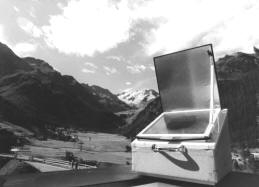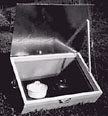m (→Gallery of manufacturers and vendors: Cat change) |
Tom Sponheim (talk | contribs) |
||
| Line 3: | Line 3: | ||
See [[Calendar of events]] |
See [[Calendar of events]] |
||
==News and Recent Developments== |
==News and Recent Developments== |
||
| + | *'''September 2012:''' Seit sieben Jahren unterstützen die Schülerinnen des Jülicher Mädchengymnasiums afrikanische Frauen in Nairobi. Diesmal reisten 15 Oberstufenschülerinnen nach Afrika, um sechs Solarkocher zu übergeben und beim Aufbau zu helfen. Trotz einiger Anfangsschwierigkeiten war das Projekt ein großer Erfolg - und zwar für alle Seiten. [http://www.wdr.de/mediathek/html/regional/2012/09/24/lokalzeit-aachen-solarkocher.xml Mehr Angaben...] |
||
[[Image:Box_cooker_in_the_Alps.jpg|right]] |
[[Image:Box_cooker_in_the_Alps.jpg|right]] |
||
| − | *'''April 2007:''' The [[Mueller Solartechnik]] company will soon release its latest solar box cooker, [[Pil Kaar 2]]. It |
+ | *'''April 2007:''' The [[Mueller Solartechnik]] company will soon release its latest solar box cooker, [[Pil Kaar 2]]. It has two opposing reflectors that automatically adjust throughout the day to track the movement of the sun, using a microcomputer powered by photovoltaic cells. This allows for constant temperatures to be maintained over extended periods of time without manual adjustment. Due to the design of the cooker and placement of the reflectors, it is recommended primarily for those in equatorial regions. '''''Contact:''''' ''[[Mueller Solartechnik]]'' |
*'''November 2006:''' [[Ulrich Zimmermann]] wrote to describe his experiences with solar cooking during vacations in the Alps mountains. He takes two cookers on his trips. He uses a small solar box cooker, designed by Group [[ULOG]] of [[Switzerland]], for cooking meals at the Alpine cottage where he stays. The cooker is placed so that the broad eaves of the cottage protect it from rain, but allow the sunshine to reach the cooker’s window. Zimmermann also uses a solar [[CooKit]], which he carries on hikes. Partway to his destination he sets up the [[CooKit]] and starts the meal cooking. He then continues hiking, and on the return trip he arrives back at the [[CooKit]] to find a tasty, hot lunch waiting for him. Zimmermann cooks his food in glass jars that are wrapped in aluminum foil. The outside surface of the foil is painted black to absorb the sunlight and heat the jars. Canning jars and lids are recommended because they release excessive steam pressure if needed. Alternatively, poke a small hole in the lid or leave it slightly loose. Zimmermann says that his trips to the Alps also testify to the importance of solar and other alternative energy sources to reduce greenhouse gasses and climate change. "In the Alps," he says, "you can’t avoid looking at the damage. … All the glaciers around have lost much of their length in the last decades by man-made climate change." |
*'''November 2006:''' [[Ulrich Zimmermann]] wrote to describe his experiences with solar cooking during vacations in the Alps mountains. He takes two cookers on his trips. He uses a small solar box cooker, designed by Group [[ULOG]] of [[Switzerland]], for cooking meals at the Alpine cottage where he stays. The cooker is placed so that the broad eaves of the cottage protect it from rain, but allow the sunshine to reach the cooker’s window. Zimmermann also uses a solar [[CooKit]], which he carries on hikes. Partway to his destination he sets up the [[CooKit]] and starts the meal cooking. He then continues hiking, and on the return trip he arrives back at the [[CooKit]] to find a tasty, hot lunch waiting for him. Zimmermann cooks his food in glass jars that are wrapped in aluminum foil. The outside surface of the foil is painted black to absorb the sunlight and heat the jars. Canning jars and lids are recommended because they release excessive steam pressure if needed. Alternatively, poke a small hole in the lid or leave it slightly loose. Zimmermann says that his trips to the Alps also testify to the importance of solar and other alternative energy sources to reduce greenhouse gasses and climate change. "In the Alps," he says, "you can’t avoid looking at the damage. … All the glaciers around have lost much of their length in the last decades by man-made climate change." |
||
Revision as of 17:55, 25 September 2012
Events
News and Recent Developments
- September 2012: Seit sieben Jahren unterstützen die Schülerinnen des Jülicher Mädchengymnasiums afrikanische Frauen in Nairobi. Diesmal reisten 15 Oberstufenschülerinnen nach Afrika, um sechs Solarkocher zu übergeben und beim Aufbau zu helfen. Trotz einiger Anfangsschwierigkeiten war das Projekt ein großer Erfolg - und zwar für alle Seiten. Mehr Angaben...
- April 2007: The Mueller Solartechnik company will soon release its latest solar box cooker, Pil Kaar 2. It has two opposing reflectors that automatically adjust throughout the day to track the movement of the sun, using a microcomputer powered by photovoltaic cells. This allows for constant temperatures to be maintained over extended periods of time without manual adjustment. Due to the design of the cooker and placement of the reflectors, it is recommended primarily for those in equatorial regions. Contact: Mueller Solartechnik
- November 2006: Ulrich Zimmermann wrote to describe his experiences with solar cooking during vacations in the Alps mountains. He takes two cookers on his trips. He uses a small solar box cooker, designed by Group ULOG of Switzerland, for cooking meals at the Alpine cottage where he stays. The cooker is placed so that the broad eaves of the cottage protect it from rain, but allow the sunshine to reach the cooker’s window. Zimmermann also uses a solar CooKit, which he carries on hikes. Partway to his destination he sets up the CooKit and starts the meal cooking. He then continues hiking, and on the return trip he arrives back at the CooKit to find a tasty, hot lunch waiting for him. Zimmermann cooks his food in glass jars that are wrapped in aluminum foil. The outside surface of the foil is painted black to absorb the sunlight and heat the jars. Canning jars and lids are recommended because they release excessive steam pressure if needed. Alternatively, poke a small hole in the lid or leave it slightly loose. Zimmermann says that his trips to the Alps also testify to the importance of solar and other alternative energy sources to reduce greenhouse gasses and climate change. "In the Alps," he says, "you can’t avoid looking at the damage. … All the glaciers around have lost much of their length in the last decades by man-made climate change."
The History of Solar Cooking in Germany
This nation has been an outstanding exporter of solar cooking equipment, knowledge, and promotion over many years, as seen in the country reports which provide information about the many places they have been active. EG-Solar, active in many international sites, attempts to provide education and equipment for people in Germany, as well.
Information that would provide the full picture of use in these major European countries is not available, though most would estimate it to be limited. Though the price of much of the equipment produced in Europe and shipped elsewhere is sufficiently high that it must be subsidized abroad, it could however be sold for backyard or patio use in Europe, and some attempts in that direction are underway. No overall information on the success of that is available.
In Germany, one small experiment in using carbon trading is in place, mentioned in the section on EG Solar. Dr. Dieter Seifert has led the solar cooking community through his thorough investigation of the potential of the Clean Development Mechanism (CDM).
The only example known to this writer (Dr. Barbara Knudson) of the mechanism being used by solar cooking promoters is one in which a small program in Nepal has been financed with funds from the German government on the basis of carbon exchange credits. Dr. Seifert has taken the lead on this matter, and the solar cooking community would do well to learn more about the potential offered by the international framework of the Kyoto agreement.
[Information for this section was taken originally from State of the Art of Solar Cooking by Dr. Barbara Knudson]
Climate, Culture, and Special Considerations
- Solar cooker dissemination and cultural variables
- July 2006: Solar Cooking in Europe - Why and How? - Michael Götz
Resources
Blogs
Reports
Articles in the media
- July 2009: FEDEX Delivers Solar Cookers to Myanmar Civil War Refugees in northern Thailand - Freight-Net
- November 2005: Germany to earn CERs through solar kitchens - Solar Cooker Review
Web pages
Contacts
The entities listed below are either based in Germany, or have established solar cooking projects there:
SCI Associates
- Main article: Solar Cookers International Association
NGOs
Manufacturers and vendors
Individuals
Government agencies
Educational institutions
See also
References







